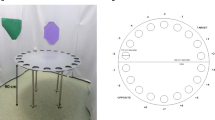Abstract
N-2-chloroethyl-N-ethyl-2-bromobenzylamine (DSP4) (50 mg/kg IP), a new selective noradrenaline (NA) neurotoxin, was found to cause a severe impairment of the acquisition of a two-way active avoidance task 1 week following adminsitration, an effect that was blocked by the selective NA uptake inhibitor desipramine. In a second experiment, systemically injected 6-OHDA (2×30 mg/kg IP) was not found to cause any avoidance impairment, althogh its effects upon peripheral NA were still evident 21 days after administration: The peripheral NA depletion caused by DSP4 almost disappeared 14 days after injection. In a third experiment, the avoidance impairment induced by DSP4 was produced even 10 weeks after treatment. Data from both the shuttlebox experiment and an activity box experiment suggest that the acquisition impairment is not readily explained on the basis of some deficit in spontaneous behavior or an altered perception of pain. The present data suggest that the effect of DSP4 upon active avoidance asquisition is mediated via central, and not peripheral NA neurons.
Similar content being viewed by others
References
Archer T (1982) DSP4 (N-2-chloroethyl-N-ethyl-2-bromobenzylamine), a new noradrenaline neurotoxin, and the stimulus conditions affecting aquisition of two-way active avoidance. J Comp Physiol Psychol (in press)
Archer T, Ögren SO, Ross SB (1981a) N-2-Chloroethyl-N-ethyl-2-bromobenzylamine hydrochloride (DSP4), a new selective noradrenaline neurotoxin, and taste neophobia in the rat. Physiol Psychol 9:197–202
Archer T, Ögren SO, Ross SB, Johansson G (1981b) DSP4, a selective noradrenaline neurotoxin, and avoidance learning in the rat. In: Bradshaw CM, Szabadi E, Lowe CF (eds) Quantification of steadystate operant behaviour. Elsevier/North Holland Biomedical Press, Amsterdam, pp 445–448
Atack C, Magnusson T (1978) A procedure for the isolation of noradrenaline (together with adrenaline), dopamine, 5-hydroxytryptamine and histamine from the same tissue sample using a single column of strongly acidic cation exchange resin. Acta Pharmacol Toxicol (Copenh) 42:35–57
Beninger RJ, Mason ST, Phillips AG, Fibiger HC (1980a) The use of conditioned suppression to evaluate the nature of neuroleptic-induced avoidance deficits. J Pharmacol Exp Ther 213:623–627
Beninger RJ, Mason ST, Phillips AG, Fibiger HC (1980b) The use of extinction to investigate the nature of neuroleptic-induced avoidance deficits. Psychopharmacology 69:11–18
Callingham BA (1966) The effects of imipramine and related compounds on the uptake of noradrenaline into sympathetic nerve endings. In: GArattini S (ed) Proceedings of the First International Symposium on Antidepressant Drugs. Excerpta Medica, Amsterdam, pp 34–43
Carlsson A, Lindqvist M (1973) Effect of ethanol on the hydroxylation of tyrosine and tryptophan in rat brain in vivo. J Pharm Pharmacol 25:437–440
D'Amour FE, Smith DL (1941) A method for determining loss of pain sensation. J Pharmacol Exp Ther 71:74–79
Eddy NB, Leimbach D (1953) Synthetic analgesics. II. Dithienylbutenyland ditheinylbutelamines. J Pharmacol Exp Ther 107:385–393
Fibiger HC, Mason ST (1978) The effects of dorsal bundle injections of 6-hydroxydopamine on avoidance responding in rats. Br J Pharmacol 64:601–605
Huang YH, Redmond DE, Snyder DR, Maas JW (1975) In vivo location and destruction of the locus coeruleus in the stumptail macague (Macaca arctoides). Brain Res 100:157–162
Jaim-Etcheverry G, Zieher LM (1980) DSP4: A novel compound with eneurotoxic effects on noradrenergic neurons of adult and developing rats. Brain Res 188:513–523
Jonsson G, Hallman H, Ponzio F, Ross S (1981) DSP4-(N-2-chloroethyl-N-ethy-2-bromobenzylamine): A useful denervation tool for central and peripheral noradrenaline neurons. Eur J Pharmacol 72:173–188
Kirk RE (1968) Experimental design: Procedures for the behavioral sciences. Brooks Cole, Belmont CA
Mason ST, Fibiger HC (1979) Noradrenaline and avoidance learning in the rat. Brain Res 161:321–334
Mason ST, Iversen SD (1977) Behavioral basis of the dorsal bundle extinction effect. Pharmacol Biochem Behav 7:373–379
Mason ST, Iversen SD (1979) Theories of the dorsal bundle extinction effect. Brain Res Rev 1:107–137
Oei TPS, King MG (1980) Catecholamines and aversive learning: A review. Neurosci Biobehav Rev 4:161–173
Ögren SO, Fuxe K (1974) Learning, brain noradrenaline and the pituitary-adrenal axis. Med Biol 52:399–405
Ögren SO, Fuxe K (1977) On the role of noradrenaline and the pituitary-adrenal axis in avoidance learning. Studies with corticosterone. Neurosci Lett 5:291–296
Ögren SO, Holm AC (1980) Test-specific effects of the 5-HT reuptake inhibitors alaproclate and zimelidine on pain sensitivity and morphine analgesia. J Neural Trans 47:253–271
Ögren SO, Archer T, Ross SB (1980) Evidence for a role of the locus coeruleus noradrenaline system in learning. Neurosci Lett 20:351–356
Ögren SO, Archer T, Fuxe K, Eneroth P (1981) Glucocorticoids, catecholamines and avoidance learning. In: Fuxe K, Gustafsson JA, Wetterberg L (eds) Symposium on steroid hormone regulation of the brain. Pergamon, Oxford New York, pp 355–377
Ross SB (1976) Long-term effect of N-2-chloroethyl-N-ethyl-2-bromobenzylamine hydrochloride on noradrenergic neurons in the rat brain and heart. Br J Pharmacol 58:521–527
Ross SB, Renyi AL (1976a) On the long-lasting inhibitory effect of N-(2-chloroethyl)-N-ethyl-2-bromobenzylamine (DSP4) on the active uptake of noradranaline. J Pharm Pharmacol 28:458–459
Ross SB, Renyi AL (1976b) Structural requirements for inhibition of the uptake of noradrenaline and 5-hydroxytryptamine by tricyclic antidepressant and related compounds. In: Knoll J, Magyar K (eds) Symposium on pharmacology of catecholaminergic and serotonergic mechanisms. Akadémiai Kiado, Budapest, pp 1–8
Ross SB, Renyi AL, Ögren SO (1972) Inhibition of the uptake of noradrenaline and 5-hydroxytryptamine by chlorphentermine and chlorimipramine. Eur J Pharmacol 17:107–112
Ungerstedt U (1971) Stereotoxic mapping of the monoamine pathways in the rat brain. Acta Physiol Scand (Suppl) 367:1–48
Zieher LM, Jaim-Etcheverry G (1980) Neurotoxicity of N-(2-chloroethyl)-N-ethyl-2-bromobenzylamine hydrochloride (DSP4) on noradrenergic neurons is mimicked by its cyclic aziridinium derivative. Eur J Pharmacol 65:249–256
Author information
Authors and Affiliations
Rights and permissions
About this article
Cite this article
Archer, T., Ögren, S.O., Johansson, G. et al. DSP4-induced two-way active avoidance impairment in rats: Involvement of central and not peripheral noradrenaline depletion. Psychopharmacology 76, 303–309 (1982). https://doi.org/10.1007/BF00449115
Received:
Accepted:
Issue Date:
DOI: https://doi.org/10.1007/BF00449115




